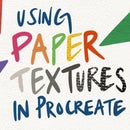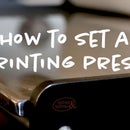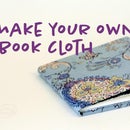Introduction: Making Art With Icecream Sticks
In this tutorial I’m going to show you how to make woodcut prints using icecream sticks. One thing that I try to do a lot when I make art is to creatively to reuse everyday waste items in my processes. We’re heading towards summer where I live and the weather is getting warmer, and when we were out on a walk eating an icecream, I realised that the wood in the sticks would be suitable for making woodcut relief prints.
Supplies
Icecream sticks (or popsicle sticks, depending on where you live)
Shellac based drawing ink
Ink brush
Small round brush (I used a Raphael 8404 4/0)
Non-slip rubber mat (you can recycle a piece of an old yoga mat)
V shaped wood or lino carving tool
Newsprint
Pencil
Marker
Ruler
Perspex or glass to use as an ink slab and to cover your registration sheet
Ink knife
Relief printing ink (I used Graphic Chemical 1796 oil based litho ink)
Printmaking roller
Thin printmaking paper (I used Japanese Hosho paper)
Printmaking baren or kitchen spoon
Paint scraper
Paper towel or recycled cloth rag
Citrus based brush/paint cleaner (you can also clean up oil based ink with vegetable oil, or clean up water based ink with a damp cloth)
Watercolours
Step 1: Preparing the Sticks and Your Design
Clean and dry your sticks, then paint them with some shellac based drawing ink.This makes it easier to see where you've carved. The shellac base in the ink also helps seal the wood and protect it from moisture during the printing process. You can choose whatever colour of ink you want for this step.
When the coloured ink is dry, you can use a very small brush and some opaque white ink to mark out the lines and areas you want to carve away. There are a lot of different ways that you can transfer images onto a printing block, and drawing directly is a good method for experimental abstract type art and simpler images. If you want to carve something more complex, a tracing or direct transfer method might be a better choice.
Keep in mind that because this is a relief print, everything is reversed, so whatever you carve will print as a mirror image. If you want to carve and print something like text, this becomes very important.
Step 2: Carving Your Woodblock
I highly recommend carving on a non slip mat. Using a mat like this (or an old piece of recycled yoga mat) stops your block from slipping while you’re carving, but you can also easily pick up the block and move it around so that you’re always carving away from your hand. It’s very easy to slip and cut yourself with a carving tool, and it hurts, so cut away from your hand and use a non-slip mat to keep yourself and your woodblock safe. This is especially important with the icecream sticks, as they’re so small that you're much more likely to slip.
Icecream sticks are usually made from baltic birch, and because they’re something you normally stick in your mouth, the surface is very smooth and carving it is easy. Go slowly and carefully, and make sure your tools are sharp. Keep your lines light and shallow.
For my carving, I only used one small V shaped tool. For a more normal sized woodcut made with plywood, you’d also generally use a knife tool and a flat chisel to clear away large areas, but that may not be necessary for such a small surface.
Step 3: Making a Registration Sheet
One of the really fun things about making experimental and abstract relief prints is that you can continue being experimental in the way that you print the imagery. With my artwork, I took full advantage of the repetitive aspect of printmaking to layer the same imagery over itself and create a pattern. Making a registration sheet before you print can be very helpful when working with the multiple this way.
To make a registration sheet, mark out the corners of your printing paper with a greylead pencil on a piece of newsprint, then rule the edges out more clearly with a marker. Trace around your icecream sticks or woodblock. Make notes for yourself and consider numbering areas so you know where to put each stick with each printing pass.
If you’re clear and methodical when you make the registration sheet, you can use it to print multiple copies of the same artwork, no matter how much experimenting you do or how many layers you need to print. With this type of registration sheet, place it underneath a clear layer of plastic or glass so that you can easily wipe it clean between each print.
Step 4: Inking Up Your Woodblock
Use a piece of thick scrap plastic, glass or tile to roll out your ink.
A thinner, stiffer ink is a good option for woodcut printing as it’s less likely to fill in the grain of the wood. Any good quality relief printing ink will work well, and if you find that your ink is too runny, you can add a stiffening agent like magnesium carbonate powder. Alternatively, if your ink is too stiff, you can loosen it up with an appropriate thinner like linseed oil.
Always start with less ink than you think you need, then add a little bit of ink to your rollout at a time to build it up if there’s not enough ink. You can always add more ink to a block, but if you roll on too much ink all at once, you’ll lose definition in your fine lines and you’ll need to clean the ink off and start again.
When you first ink up your block, you’ll need to roll several times over it to add enough ink for printing. Your very first print might not be all that great, but repeated prints of the same block will only require a top up of ink and should print more evenly.
Step 5: Printing by Hand With a Baren or Spoon
When you’re ready to print, place your icecream sticks (or your plywood or lino block) onto your registration sheet, give your hands a clean if you got ink on them, then carefully place your piece of paper down. Always place you paper from the same corner, as this helps keep the registration more accurate.
I have a teflon brayer that is great for some things, but for certain prints I find that I can’t transfer enough pressure with it. I still find it useful for pressing the paper down gently before I go in more heavily with the back of a spoon.
Because the icecream sticks are so small, if you print multiple blocks in one pass, you'll need to be careful not to accidentally push or move them while printing. Go slowly and carefully, and if you find that it’s too difficult to print more than one stick at a time, you can print them individually in multiple passes. Be sure to watch the video included with this tutorial to see the processes in action.
When you’re printing by hand like this, your prints will work out better if you choose a thinner, smoother paper. Thin Japanese papers are particularly good for this type of printing, as they’re generally made with quite long fibres and are a lot stronger than they look.
Step 6: Cleaning Up
When you’re done printing, you’ll need to clean up your ink and tools. I know it’s not the most fun part of making art, but it’s super important.
Start by scraping away excess ink with a scraper blade, then roll out as much ink as possible from your roller and scrape that up as well. When you've cleared away as much ink as you can with the scraper, use a rag and some citrus based cleaner to wipe down your roller, tools, woodblocks and inking slab. If you’re printing with oil based ink, you can also clean your slab with vegetable oil, and if you’re using water based ink or water soluble oils, you can use a damp cloth.
Step 7: Hand Colouring and Finishing Your Woodblock Prints
When your prints have dried overnight, you’ll be able to hand colour and finish them any way you want.
You’ll generally have a couple of prints where something moved and smudged, or just didn’t print quite as well as you wanted, so it’s good to use these reject prints to experiment with different colours and finishing options.
And that's how you can make a woodblock print using an icecream stick!

Participated in the
Trash to Treasure Contest













